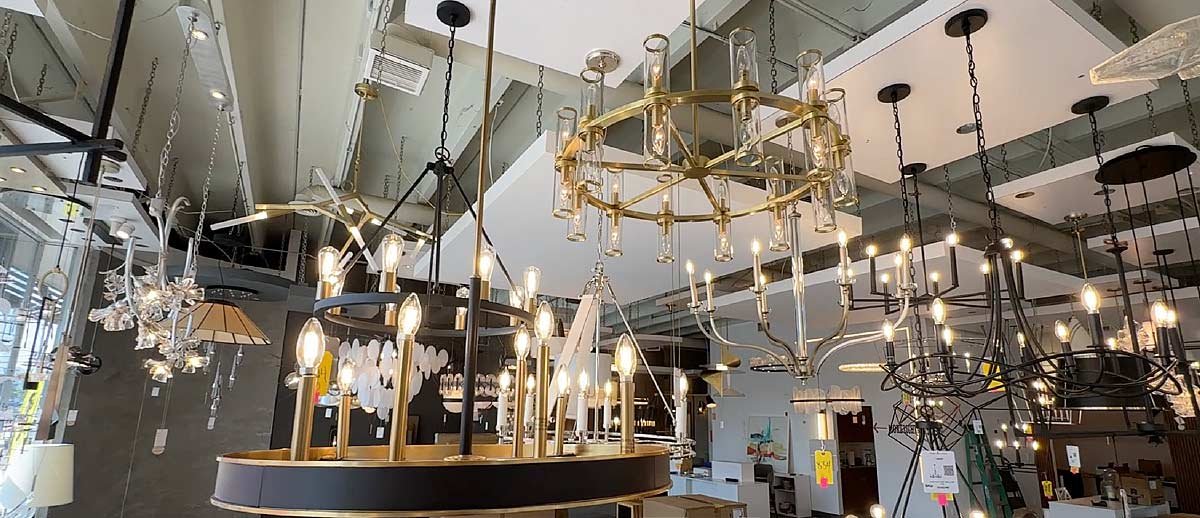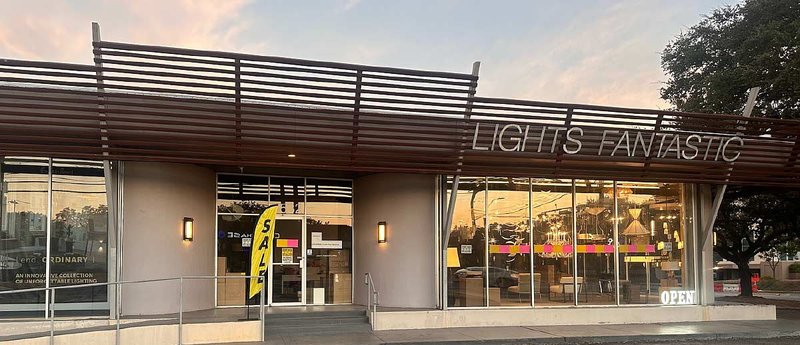
The Brick-and-Mortar vs. e-commerce for Home Accessories, Furniture, and Lighting
Published by Scott Oldner on Oct. 9, 2025, 3 p.m.
In an era embracing digital convenience, the traditional brick-and-mortar retail landscape for home accessories, furniture, and even lighting has been undergoing a dynamic transformation. Once bustling hubs for home improvement enthusiasts, these physical stores continue to adapt and innovate amid challenges, challenge that have led to closures, bankruptcies, and shrinking sales figures. As of 2025, the industry continues to grapple with a post-pandemic reality where consumer behaviors have shifted dramatically toward online shopping. Before the internet explosion we would take our evenings and weekends and scour our city for items like a sofa, chair or pendant light evaluating all the options of price, aesthetics, ergonomics and style for the one item that fits, and we fall in love with and take home. Years ago, stores would see their showrooms filled with shoppers on the weekends enough to where additional temporary personnel were hired just to handle the increased traffic.
Let’s explore the current state of decline, underlying reasons, notable case studies, the rise of alternatives, and what the future might hold for this sector.
The Current State: lower sales for both channels
The furniture and home furnishings industry has seen consistent sales declines over the past few years. In 2024, combined sales for the top 100 furniture retailers totaled $51.6 billion, marking an 8% drop from $56.1 billion in 2023 and a nearly 15% decrease from $60.6 billion in 2022.(furnituretoday.com) Three-quarters of these retailers reported sales drops, with conventional furniture stores experiencing a 9.8% decline and specialty retailers seeing a 5.8% fall. .(furnituretoday.com) Overall, the sector was down 9.6% in 2024, driven largely by an 8.6% reduction in furniture sales. (therobinreport.com) Store closures have accelerated this downturn. High-profile bankruptcies in 2024, such as Big Lots closing all 963 stores and Party City shutting around 700, underscore the broader retail apocalypse affecting adjacent sectors. In the home decor space, over 2,000 retail stores have vanished since 2023, prompting questions about where consumer dollars are migrating—often to online giants like Amazon. Furniture sales, a highly cyclical category, remain 17.7% below their peak, reflecting broader economic hesitancy. Even e-commerce in this category has faced headwinds, with online furniture and home furnishings purchases dropping to 18% of respondents in surveys, down double digits year-over-year.(furnituretoday.com) However, absolute online market values are still projected to grow, highlighting a complex interplay between channels. These numbers show that there is a similar decline in on-line sales as there is brick and mortar sales. So why are stores closing?
Economic Pressures and Consumer Shifts
Alongside digital growth, macroeconomic factors are sparking creative solutions. Easing interest rates and a recovering housing market are poised to boost demand for big-ticket items like furniture and lighting. Home sales influences furnishings purchases, and with anticipated increases in transactions, retailers are gearing up for opportunity —evidenced by a 2.5% drop in household furnishings prices in May 2024, making products more accessible(forbes.com). Non-essential spending on furniture and home furnishings is stabilizing after temporary consecutive months of declines. Overall, furniture sales are rebounding from the 17.7% dip and show a strong potential ahead. Strategic responses to Inflation, supply chain disruptions, and new tariffs are fostering domestic innovation and affordability. The industry is capitalizing on economic uncertainty, as evidenced by Q4 2024 's positive momentum. E-commerce in furniture and home furnishings remains a key growth area, reflecting opportunities for omnichannel strategies amid consumer caution. (furnituretoday.com)The homeware market is growing modestly, from $139.08 billion in 2024 to $143.62 billion in 2025, with physical stores well-positioned to capture a share through enhanced experiences while embracing e-commerce sales channel.(thebusinesssearchcompany.com)
The Digital Migration
The rise of e-commerce has challenged physical retail's advantages. Online sales grew 6.7% during the 2024 holiday season, outpacing in-store growth of 2.7%, with over half of transactions on mobile devices.(lightboxre.com) Practices like “webrooming” (researching online before in-store buys) and “showrooming” (browsing in-store but purchasing online for better prices and delivery) proliferate, with 59% of consumers engaging in the latter. (lightboxre.com) For bulky items like furniture, augmented reality (AR) tools allow virtual try-ons at home, reducing the need for store visits and even though AR cannot compete with seeing the item in person AR is not widespread but loved by a younger techy consumer. Brick-and-mortar stores now face higher operational costs—payroll, rent, and energy—without the foot traffic of yesteryears, making them the most expensive sales channel compared to online competitors with minimal overhead.
Case Studies:
At Home's Bankruptcy
A stark example is At Home, a chain with over 200 U.S. locations specializing in home decor and furniture. In June 2025, it filed for Chapter 11 bankruptcy to restructure, aiming to shed $2 billion in debt and secure $200 million in new capital. (cbsnews.com)The company cited tariffs, inflation, and a missed interest payment as triggers, alongside broader issues like sluggish housing and low demand. As a result, 26 stores are closing by September's end, following six closures in the prior year. (cbsnews.com) Ownership is shifting to lenders, with the CEO emphasizing improved competitiveness post-restructuring. (cbsnews.com)
Local Lighting: Lights Fantastic and Porter Lighting

After 54 years in Dallas and 52 in Austin, Lights Fantastic (along with their other brands Fleco and Saylites) was sold in 2022 to a private equity firm that eventually in the summer of 2024 shuttered all three brands. Reports say that the stores were still viable and turning a profit but the manufacturing couldn’t keep up with the pressures from cheap Chinese goods in the commodity and not-quite-commodity commercial lighting fixtures market.
Porter lighting boasted and even longer tenure in the retail lighting market of 81 years until it’s closure in the summer of 2025. The exact reasons for Porter closing is not generally known but shows the pressure of on-line sales can affect even the longest-lived companies in the lighting sector.
The Rise of Alternatives
E-commerce platforms offer vast selections, competitive pricing, and conveniences like free shipping and returns. Smart home decor, projected to capture 25% of the market by 2025, integrates lighting and accessories with tech, often sold online. (news.market.us) Social commerce, generating $15-16 billion in 2024 U.S. sales via platforms like TikTok, influences purchases through live demos and user content. Hybrid models, where stores serve as fulfillment centers, may salvage some locations.
The brick-and-mortar survivors have embraced e-commerce as well with such entities as Build By Ferguson, Lighting, Inc and Visual Comfort. Visual Comfort’s new store in Austin falls into a slightly different category since it is a single manufacturer’s store and it shows that high-end, designer items are best evaluated in person, and it is more akin to a designer showroom.
Outlook: Challenges and Opportunities
Looking to 2025 and beyond, the decline may persist but with glimmers of recovery. Anticipated Federal Reserve rate cuts could stimulate housing and spending, potentially boosting Christmas sales by a few points. (therobinreport.com) Retailers must adapt by integrating AI, AR, and/or omnichannel strategies to blend physical and digital experiences. (lightboxre.com) While brick-and-mortar may never reclaim its dominance, resilient players could re-energize the industry through innovation, educating the consumer and affordability.
In conclusion, the decline of brick-and-mortar stores for home accessories, furniture, and lighting reflects broader retail evolution. Economic headwinds and digital disruption have accelerated closures, but strategic pivots offer a path forward. As consumers demand seamless, value-driven experiences, the survivors will be those who evolve beyond four walls but maintain four walls.
We consumers will still visit brick and mortar stores and will continue to want to sit in that chair, evaluate the sparkly nature of a chandelier in person and see choices side by side even if it is fewer choice, especially for items that are hard to understand from on-line sources. Those stores that succeed will continue and improve upon educating the consumer and giving sage advice. That advice and/or design assistance can best be done in a face-to-face environment where the consumer can see the alternatives, couple that with a professional designer’s opinion and then make the decision for themselves. The design advice process is still too cumbersome on-line.
Lights Fantastic and Porter Lighting Liquidation sale:



